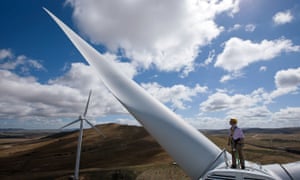
A sharp drop in Australia’s greenhouse gas emissions at the end of last year came courtesy of a spike in renewable energy generation in a single month, according to a new study.
Australia’s emissions fell by 3.57m tonnes in the three months to December, putting them back on track to meet quarterly commitments made in Paris after a blowout the previous quarter.
The fall is the largest for the quarter since the government began recording emissions in 2001. The report’s authors said this was entirely due to record levels of hydro and wind generation in October. This brought emissions for the year to December to below the year to December 2015.
But projected emissions for the December quarter were still 6.89m tonnes over levels demanded by scientifically based targets set by the government’s Climate Change Authority.
And, long term, the results show Australia is set to run more than 300m tonnes over what is required to meet its Paris targets in 2030.
It aims to produce a more timely account than the government’s, which is six to nine months behind.
In the four years to December 2016, Australia emitted 20.7% of its share of what the world can emit between 2013 and 2050 if it intends to maintain a good chance of keeping warming to below 2C.
If Australia continues to emit carbon pollution at the average rate of the past year, it will spend its entire carbon budget by December 2031. Projected to the current second, the graphic shows how much of the carbon budget has been spent.
Matt Drum, the managing director of Ndevr Environmental, said the figures showed renewable energy was “the only thing that’s keeping us in the ballgame” of meeting climate commitments.
With the electricity sector the largest and most variable factor in Australia’s emissions, these October spikes in renewables were alone enough to drive the quarter “under the trajectory we need for Paris”, he said.
“We’re still churning through our carbon budget pretty quickly and, if you run a trend line from when we made our Paris commitment, we’re still way over and getting further and further behind,” Drum said.
He said renewable energy was the single key factor driving down Australia’s emissions profile, ironically at a time when the sector was under attack from the federal government.
Coalition government figures have sought to blame renewables for blackouts in South Australia, despite others pointing to energy market failures.
Government figures including the prime minister, Malcolm Turnbull, have attacked more ambitious state renewables targets as unfeasible and talked up the benefits of new coal-fired power stations and channelling “clean energy” funding towards them.
Drum said the government was “undermining the only policy lever that’s having any impact on our emissions trajectory”.
“The only thing that’s keeping us in the ballgame at all is our renewable energy generation,” he said. “This makes sense when there’s no other feasible carbon policy on the table at the moment. ERF [the emissions reduction fund] isn’t doing it. Direct Action more broadly isn’t going anywhere near it …
“But if they want to peel back renewables, there’s nothing left.”
An independent review of the state of Australia’s environment released on Monday found the impacts of climate change were increasing and some could be irreversible.
The environment minister, Josh Frydenberg, in a column for Guardian Australia, said the report “makes clear that, for the world to meet its Paris goals, there is much more to do”. He noted carbon emissions per capita had declined from 24.1 tonnes in 2011 to 22.2 tonnes in 2015.
But the report showed Australia needed to “put in place a coordinated, comprehensive, well-resourced, long-term response” or risk leaving “a legacy to future generations that is inferior to the one we have inherited”, Frydenberg said.
Late last year the government began a review of its Direct Action climate policy, which has been widely criticised by experts as inadequate if Australia is to meet its Paris targets.
Shortly afterwards Frydenberg was forced to rule out converting Direct Action to a form of carbon trading after an internal Coalition revolt. Many experts and institutional investors argue carbon trading would allow Australia to cut emissions in line with Paris commitments at the least cost to households and businesses.
The carbon budget recommended by the Climate Change Authority, which it described as “equitable and feasible”, was never agreed to by the government but represents the authority’s view of Australia’s fair share if global warming is to be kept under 2C.
Direct Action is the federal government’s primary carbon reduction tool, which pays polluters to pollute less through a reverse auction – the emissions reduction fund.
There is no evidence the emissions bought through that fund, now largely spent, reduce overall emissions and many of the emissions the government pays to avoid are unlikely to have occurred anyway.
source: https://www.theguardian.com
No comments:
Post a Comment